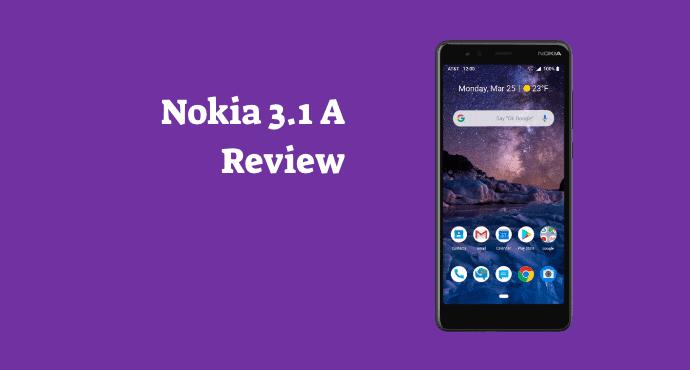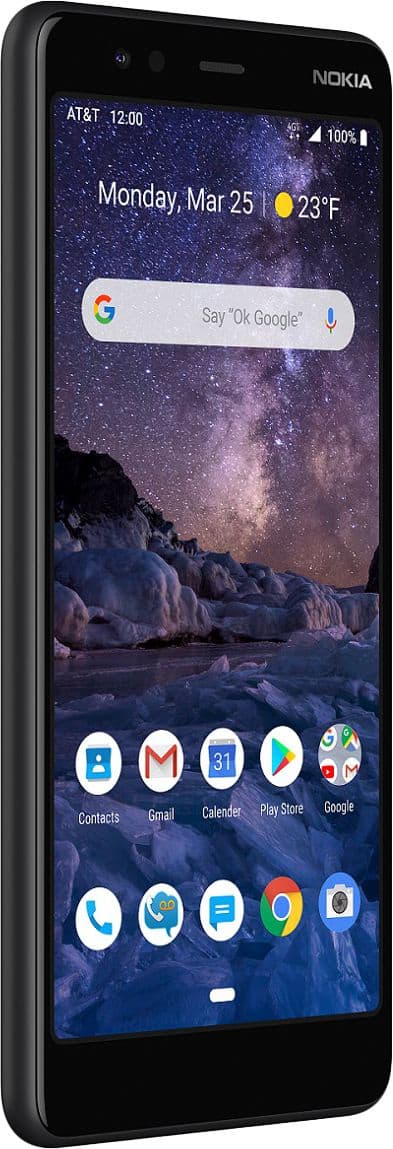Shopping for budget smartphones can be a huge make or break. Check out this Nokia 3.1 A review to see if this device is worth all the money you spend.
The Nokia 3.1 A smartphone was released in 2019. Everyone knows that Nokia is famous for its iconic ringtone. Even though other prominent brands are dominating the public, Nokia remains timeless.
A while ago, the brand broke into the competitive smartphone market with the Nokia 3.1 A. Marketed within the low cost range, this device boasts some solid features that will leave us hooked.
Budget smartphones are attractive thanks to its price. However, they also pose a huge risk. If we’re not careful in selecting our options, we might end up with a faulty phone.
Don’t worry, our Nokia 3.1 A review has got your back. Take a look at what we have to say about this product.
Page Contents:
Key Specs
Nokia 3.1 A specifications:
- Weight: 156g
- Dimensions: 153 x 72 x 9.4mm
- OS: Android Version 9.0 (Pie)
- Screen size: 5.45-inch
- Resolution: 1440 x 720
- CPU: 2GHz Quad-core, Qualcomm Snapdragon 429
- RAM: 2GB
- Storage: 32GB
- Battery: 2,990mAh, non-removable
- Rear camera: 8MP
- Front camera: 5MP
Design
The Nokia 3.1 A has a tall, long structure that feels good in our palms. It’s more on the slimmer side with a nice build. Right on the front side, we have our phone display. The top and bottom bezels are slightly thick, whereas the rest of the sides are thin. Since this is a budget phone, aesthetics might not have been the developers’ top priority.
The front-facing camera is tucked on the top left, with a Nokia branding on the top right. In between is the phone’s earpiece. Moving onto the back, we can find the rear-facing camera and LED flash. It also features a single backfiring speaker but has no fingerprint sensors.
The back cover has a matte layer to it, leaving a smooth finish. Complementing the cover is another Nokia branding in a bigger size. While the battery is non-removable, we can remove the back cover. Inside, there is a card tray to put in our SIM card and microSD.
The rest of the sides are kept in a pretty simplistic tone. The right side has a basic power button and volume controls. However, there are no buttons at all on the left side. The top side features the 3.5mm headphone jack and a noise cancellation mic. Meanwhile, the bottom side has a microphone and a Type C charging port.
Display
The Nokia 3.1 A has a 5.45-inch display supported by a 1440 x 720 resolution. It’s not the biggest of all display screens. Considering it’s a budget smartphone, we don’t expect so much. The phone can produce vivid imagery on its screen.
The phone comes with an 18:9 aspect ratio display. Complemented by its long build, the phone can mimic a wide-screen viewing experience. The phone also allows room for zoom in and zoom out to fill in the display. Plus, the thick top and bottom bezels help us hold the phone display efficiently.
We’re surprised by the phone’s decent quality. The Nokia 3.1 A uses HD+ technology to offer more colors, textures, and motions with visuals. We are treated to 295 pixels per inch and a total of 16 million colors on the screen. It’s rather impressive for something within the low-price range.
The technologies used for the display screen has made the phone even more solid. Users can watch videos in high resolutions. Per our checking, we can view up to 720p at 60 frames per second. The display doesn’t have any trademark qualities, but it has strength and consistency.
Read also:
Camera
The Nokia 3.1 A has an 8MP rear camera and a 5MP front camera. Both cameras are satisfactory and do not run into major issues. The rear-facing camera does not have high megapixels, but it can still take sharp images. The auto-focus works quite well, with not much focus hunting when taking fast shots.
Recording videos are a bit of a hassle with budget phones. The recordings tend to come off shaky or laggy. The phone can capture videos with a 1920 x 1080 resolution supporting 30 frames per second. In simpler terms, we can still achieve stability as motion blur is minimized.
We also have a 5MP front-facing camera for our urgent selfie needs. This amount of megapixels for a front camera is the bare minimum with budget phones. Accompanied by an f/2.2 aperture, we can take nice portrait photos with me. Sadly, there’s no wide-angle option to accommodate group selfies. However, we do have beauty mode for a quick touch up.
To spice things up, the Nokia 3.1 A has several shooting options to pick from. On the camera interface, we can switch to Square, Panorama, and Time-lapsed. There are also many flash options and timer options available. These tools help us make sure we get our one perfect shot.
Storage
The Nokia 3.1 A has internal memory storage of up to 32GB. One common issue users oftentimes run into is that we cannot fully access its raw hardware. While it says that 32GB is available, in reality, that’s not the case. The phone’s preloaded bloatware has already taken up a portion of the internal memory.
To free up the internal memory storage, be sure to uninstall any unnecessary bloatware. For a more hassle-free alternative, we can choose to expand the storage. The phone lets us install a microSD card of up to 128GB. It’s a simple step that can provide more room to accompany the phone’s small internal storage.
Performance
The Nokia 3.1 A is powered by a 2GHz Qualcomm Snapdragon 429 processor with a 2GB RAM. The processor is a chipset commonly used in mid-tier budget phones. Despite its cost-friendliness, it helps the phone perform adequately. Users are treated to smooth visuals and surprisingly great camera quality.
Additionally, the processor balances multiple activities on the phone. Under this support, the phone can function properly without sacrificing much battery life. The processor also plays a crucial role in the connection. It is the heart that gives life into cellular technology, Wi-Fi, and Bluetooth.
This Nokia 3.1 A review pays attention to the phone’s overall performance. This includes taking a look into its 2GB RAM. Develops have invested a lot of time and effort into perfecting a phone’s RAM. Phones that have a huge RAM are categorized under the high-price range. Since we’re assessing a budget phone, it’s not surprising to see it’s supported by 2GB RAM.
Even though this is the norm with affordable smartphones, it still slows down the performance. Multi-tasking will be an issue if there are too many apps running in the background. One way to solve this issue is to constantly clear the cache every day. Cleaning up our phones; RAM is an important step to better maintain our devices.
The phone operates on Android 9 for its software. Sometimes referred to as the Android Pie operating system, Android 9 has a few tweaks up its sleeve. For starters, we found that notifications pop up more cleanly. We also noticed that Android 9 supports some Google-based applications. These include the highly-anticipated Google Assistant and Google Motion.
However, every operating system has its ups and downs. Android 9 has updated its gesture controls with newer options. Navigation changes become more apparent on the phone. These alterations may not be everyone’s cup of tea as some are already used to past configurations. This also applies to the system’s update system notifications, which may appear naggy.
The Nokia 3.1 A is complemented by four main sensors. The accelerometer is designed to detect movements and can accurately calculate how many steps we have taken. The gyroscope then further supports this by pointing out the phone’s orientation. We can see this when playing games that require movements from left to right.
For the phone’s brightness needs, the ambient light sensor comes in to maintain this. This makes sure that the phone’s brightness levels can automatically adapt to its surroundings. Keeping up with the phone’s sensitivity levels is its proximity sensors. This prevents unwanted phone touches when we hold the phone close to our ears.
Connectivity
The Nokia 3.1 A accommodates 3G, 4G, and 4G LTE networks. Before we can use the phone, we’ll need to activate the connection using a Nano SIM card. Unfortunately, the phone doesn’t support dual-SIM cards. But it can use alternative networks, such as GSM, GPRS, and EDGE.
Not a fan of data connection? Then skip right to its Wi-Fi feature. It just so happens that the phone is capable of making calls through Wi-Fi. If others need a decent connection, we can give it to them. All we have to do is switch on Mobile Hotspot. Unfortunately, the phone can only connect up to 5 devices at the same time, which is not a lot.
Battery
The Nokia 3.1 A runs on a 2,990mAh non-removable battery. This capacity can provide the phone with more than enough power to last a day. Under normal conditions, the phone can last up to 18 hours of talk time. In other words, we can leave the phone on standby for up to 34 hours. We can watch many videos in one sitting without going back and forth to charge it.
Speaking of charging, the battery does take a while to charge. For a 50% charge, it will require 41 minutes. Meanwhile, for a 100% charge, it needs up to 124 minutes, or roughly 2 hours. This might not be pleasant to hear, but this is normal for budget phones. Other devices may even require 3 hours or more for a full charge.
Is the Nokia 3.1 A a good phone?
We have assessed the phone through several aspects through our Nokia 3.1 A review. So far, the device does look promising. It has a sophisticated design that’s light and portable. Developers have created a solid foundation for its features. The only thing we wish for improvement is its RAM size and charging time.
At a $49.98 price point, we wouldn’t complain so much. A reliable budget smartphone for long-term usage is hard to come by. However, the Nokia 3.1 A is a device that can get the essentials done without much problem. Be sure to correctly maintain it so it has a longer life.
Nokia 3.1 A Pros
- HD+ display screen
- Stable cameras
- Huge expandable memory
- Long-lasting battery life
Nokia 3.1 A Cons
- Low RAM size
- Long charging time




